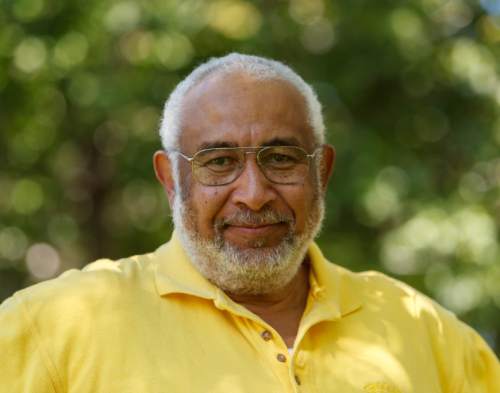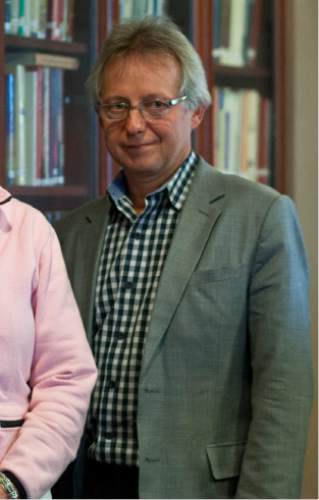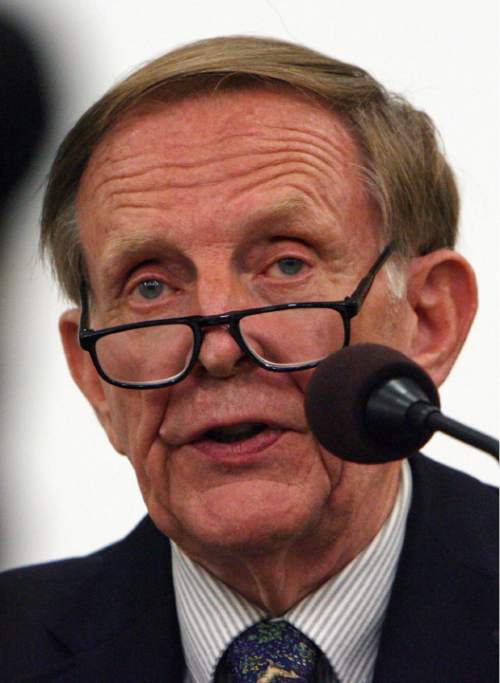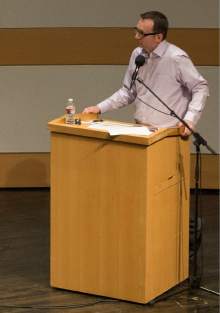This is an archived article that was published on sltrib.com in 2015, and information in the article may be outdated. It is provided only for personal research purposes and may not be reprinted.
Mormonism begins with a simple story of heavenly manifestations.
A 19th-century farm boy in upstate New York prays in a thicket of trees and sees God and Jesus. The boy next uses spiritual powers to unearth ancient writings, which he translates into English with the help of Old Testament aids. He founds a faith as a "restoration" of early Christianity, adds more scriptures to the biblical canon, introduces unique doctrines and creates a community of believers.
These tales of Joseph Smith's founding of the LDS Church have been repeated across the globe by generations of Latter-day Saints, as well as Mormon missionaries, eager to convert others to what they believe.
Trouble is, the real history is much more nuanced, complicated, even contradictory.
In one "First Vision" account, Smith said he saw one godly being, not two. He peered into a hat, which held "seer stones," to produce the sacred scripture. He secretly married dozens of women and lied to his first wife, Emma, about it.
Now, prompted by the rise of social media, the availability of LDS documents, groundbreaking scholarship, widespread Internet sharing of little-known aspects of the faith's past and a disturbing exodus of the formerly faithful, Mormonism is in the midst of a landmark effort to integrate new details about its founding — without losing the power of a simple narrative.
Can it add layers of what some see as controversial information without scaring away new converts or longtime members whose devotion is built on the account as they've known it all their lives?
Many historians insist such a shift is not only possible but also essential.
"People may be comforted in the short run by platitudes, but I don't think that leads to growth or to effective action," says Harvard historian and Pulitzer Prize-winning author Laurel Thatcher Ulrich. "The answer isn't to replace simplistic stories with footnoted essays. It is to tell better, more complete, stories, stories that are true, that touch issues people really care about."
Others worry that something might be lost in the recalibrating.
"No religion I know of would want to turn its founding stories into history, at least as history is understood today in a scientific sense," says Kathleen Flake, who heads up Mormon studies at the University of Virginia. "Faith is not about fact; nor about fiction, for that matter. It's certainly not a question of sophistication, at all, but of religious sense."
Can 21st-century followers continue to grasp the magical and miraculous in a rational era? Can the church appeal to intellectuals while retaining members more at home with the supernatural?
The Church of Jesus Christ of Latter-day Saints believes it can — and is taking steps to do so. Ever so gingerly.
—
Tackling tough topics • In December 2013, the LDS Church posted on its website an essay titled "Race and the Priesthood."
The piece probed the prohibition on black men from being ordained to the denomination's all-male priesthood, how it developed, the folk teachings surrounding it and what it took — a divine decree — to eliminate the ban in 1978.
It began under Brigham Young, second LDS president, who was influenced by common racial beliefs of the time, the article says. The policy did not exist during the tenure of Smith, who opposed slavery and personally ordained several African-Americans.
In other words, the ban stemmed more from earthly racism than heavenly revelation — a major change from how most Mormons saw it.
The LDS Church has posted other carefully crafted essays, addressing thorny questions such as "Are Mormons Christians?" "Do Latter-day Saints believe they will become gods?" "What was the nature and extent of polygamy from Smith's era through its formal end and beyond?" "How did the Book of Mormon and the Book of Abraham come to be?"
The point was to bring the best scholarly insights to the knotty, complex questions of the faith's history and theology, providing a place for members who discover vexing information on the Internet to get authoritative, yet faith-based answers.
Unfortunately, the essays' rollout, notes University of Utah historian Paul Reeve, "was spotty."
The pieces were not signed by LDS leaders, not prominently displayed online nor sent to bishops to be read over the pulpit to Mormon congregations.
At a recent panel discussion at LDS Church-owned Brigham Young University, about a third of the audience of around 80 students had neither read nor heard of the race essay, says Reeve, author of the just-released "Religion of a Different Color: Race and the Mormon Struggle for Whiteness." "Others, both professors and students, told of stories whereby they drew upon the essay in church meetings and were met by resistance from fellow Mormons who said the essays were not official and merely [church] Public Affairs pieces."
Such an approach — "make the information available, but not too available" — is "not tenable," the U. scholar says. "It now needs to be integrated into the curriculum at the local level … included in [LDS] seminary, institute, Sunday school (youth and adult), Primary and BYU Religion Department curriculums."
It doesn't have to be a wholesale rewriting of history, Reeve says, "to acknowledge new information."
American history went through a similar shift in the 1970s, he says, "as the Vietnam War forced the nation to contemplate defeat."
History textbooks began to include, he says, the perspectives of "black slaves, Native Americans, Asian immigrants, Hispanics and other marginalized groups whose stories did not always match the triumphal master narrative that had dominated earlier versions."
Telling the Mormon story the way it always has is no longer an option, Reeve argues. "The rising generation craves a more complicated narrative. Their lives are complicated; they are dealing with real struggles and real sins and a whitewashed version of the past with pioneers who only sang as they walked and walked and walked gives them nothing to identify with and sometimes even feels alienating. We can do better. We must do better."
The LDS Church does plan to fuse the essays' information into its curriculum, says spokesman Eric Hawkins. "These materials represent the very best of research on church history and doctrine, and they will, over time, be incorporated into church curriculum, publications and, where appropriate, visitors centers."
Hawkins declined to offer further details about when and how such an integration would happen or to grant interviews with historians and educators working within the bureaucracy.
Mormon scholars working independently, however, have no such reluctance. They view this as a crucial and urgent task, and worry that if the church fails to do it, a steady stream of members may continue to slip away.
—
Adding layers • Terryl Givens, co-author of "The Crucible of Doubt" and "The God Who Weeps," tells of a Mormon missionary who came across Richard Bushman's "Rough Stone Rolling" during his years of proselytizing.
Bushman's acclaimed biography is an "unstintingly honest account of the life of Joseph Smith," Givens says, yet the missionary called it "the greatest faith builder I ever read."
"I thought, 'if God could work with a vessel that imperfect to bring about the restoration,' " the young man told Givens, "maybe he could use me, too."
No one is advocating reading a 700-plus-page biography to LDS high-schoolers, Givens says, but church instruction should draw on the "best history available ... familiar and accessible."
It could start by including controversial elements into missionary discussions and member lessons "in a matter-of-fact way," explains Adam Miller, philosophy professor at Collin College in McKinney, Texas.
LDS General Conference talks "could be devoted to covering the same subjects as the essays," Miller says. "Coming from apostles at General Conference, who would bat an eye? And who wouldn't love the fresh material?"
Miller, author of "Letters to a Young Mormon," would like to see LDS visitor centers address the topic of the church's practice of polygamy, which the faith abandoned in the late 19th and early 20th centuries.
That would "put a human face on [polygamy], de-sensationalize it, and clearly frame the whole thing as a part of the Mormon commitment to the eternal family," Miller says. "People will respond positively to the candor and complexity. If I were investigating the church, candor and complexity are exactly what I would be looking for."
Bushman, emeritus professor of history at Columbia, believes Mormon faith would be enhanced rather than scandalized by past episodes brought to light in the essays.
For example, Emma Smith's account of her husband using "seer stones in a hat" to translate the religion's signature scripture, the Book of Mormon, is "one of the most powerful testimonies of the book that we have," Bushman says. "The information about the seer stone in the hat is integrated into this testimony. It only makes the translation story more concrete and real."
Samuel Brown, an LDS physician and researcher in Salt Lake City, sees value in recognizing Smith's embrace of physical items.
"God revealed ancient scripture to Joseph Smith through his encounters with sacred objects, using Smith's human mouth and mind to reveal that scripture," says Brown, author of "First Principles and Ordinances: The Fourth Article of Faith in Light of the Temple." "For the Book of Mormon, it was the [gold] plates and interpreter stones; for the Book of Abraham, it was a funeral papyrus."
Revelation and scripture, he says, "are the marks left in our mortal world by encounters between God and human beings."
What about modern Mormons who don't find God in physical objects and cannot relate to the worldview of a different century?
—
Multiple audiences • Believers of every stripe filter scripture and historical events through the prism of their time, culture and maturity.
"An 8-year-old," Brown says, "doesn't need the same story that an adult convert in Congo needs, who doesn't need the same story that a recovering addict needs, who doesn't need the same story that a middle-aged professor needs."
Some Mormons need to hear and tell stories about "exceptionally godly individuals ... to make God real in their lives," he says. "Many of us aren't built that way. Many of us feel more disappointment, perceive more acutely human failings, feel more skeptical about claims to human godliness. ... Such stories don't seem real to those listeners, they seem misleading or made up."
Thus, trying to force "a rewrite of those stories to suit some of us is like forcing everyone else to go off their [high] blood-pressure medications because we have low blood pressure," the physician says. "It's much better to work toward a complementary system in which people with high blood pressure get pills to drop the blood pressure and those with low blood pressure have an exercise regimen instead."
Adopting such a multifaceted approach, Brown says, "will take substantial culture change, with commitment on all sides."
Bushman argues that adding new and sometimes-troubling information is less unsettling for children and converts.
"They are learning lots of marvelous things. A few more are not hard to take," Bushman says. "The real problem is for the people who were taught in the old way not to get anxious."
After coming across disconcerting facts regarding LDS history or preaching, some Mormons have left the fold not because of the information itself, but because they never were told about it. They feel betrayed.
Others who were at ease in the faith — comfortable with, and comforted by, the stories as they were always taught them — were shaken by the essays.
Then there are the vast numbers of Mormons spread across the map.
" 'Church history' in any level of detail is quite elusive for members outside of the United States," writes Melissa Inouye, who teaches Asian history at the University of Auckland in New Zealand. "Especially in translation, American names, places and historical contexts are difficult to remember."
That leads to "heavy oversimplification of the few historical figures whose names can be remembered," Inouye says, and they are seen as "nearly perfect."
Such excessive veneration, she says, is neither helpful nor true.
"Even in small, episodic doses, 'messy' history is so interesting because it involves real people and real problems, with which everyone can identify," Inouye says. "What we see when we learn all of our history is, as in the scriptures, a narrative of God's dealings with real people as they make mistakes and try again."
Even prophets and apostles.
—
Familiar dilemma • One group of Latter-say Saints has had to balance an awareness of the fallibility of their religious leaders with their faith: black Mormons.
On the eve of his baptism in 1964, and at the height of the civil rights movement, Darius Gray learned about the priesthood ban. He was appalled, but after a night of prayer, Gray says he felt a divine confirmation that he should join the LDS Church — even though he thought the missionaries had to be "God's most bigoted messengers on Earth."
Gray believes the uncomfortable facts of Mormon history cannot be told "timidly or dishonestly or apologetically."
"We are an adaptable species and people young and old generally accept facts when they are presented in a clear and open manner," Gray says. "The key often is in understanding the 'why.' Why are those stories important? Why should they matter to me? What kernel of knowledge do they hold that could make my life better?"
Mormon history is an exquisite tapestry that can be presented "both as a brief synopsis and as a lengthy narrative. It doesn't have to be one or the other," he says. "Each element can support the whole without conflict when focused on the why. ... Due to our own imperfections, we understand human shortfalls and are often open to forgiveness."
One day, perhaps, most Mormons will welcome that view.
"In another 20 years, all of our historical facts will be second nature to Mormons," Bushman says. "The seer stones will be no more difficult to accept than the gold plates themselves."
Mormons, like other religious devotees, believe in "marvels," he says. "That is an obstacle for unbelievers; it is a source strength for believers."
The faithful are united in the conviction "that strange and wonderful things happened to Joseph Smith," he says. "God was with him then, and he is with us now."
Twitter: @religiongal —
From Abraham to blacks to Brigham
O They have tackled touchy topics:
Did Mormon leader Brigham Young order the Mountain Meadows Massacre? Do Latter-day Saints believe a man can become like God? How did Joseph Smith translate the Book of Abraham?
These are just some of the prickly questions confronted in a string of provocative essays released by The Church of Jesus Christ of Latter-day Saints.
To read summaries of past articles and view links to Salt Lake Tribune stories and the essays themselves, go to http://tinyurl.com/o6zqjpx.


![Rick Egan | The Salt Lake Tribune
University of Utah historian Paul Reeve, moderating a panel discussion in 2014, argues new LDS Church essays need to be "integrated into the curriculum at the local level Ö included in [LDS] seminary, institute, Sunday school (youth and adult), Primary and BYU Religion Department curriculums.î](https://archive.sltrib.com/images/2015/0329/mormonessays_030815~7.jpg)






